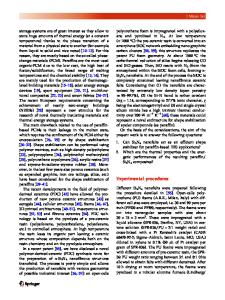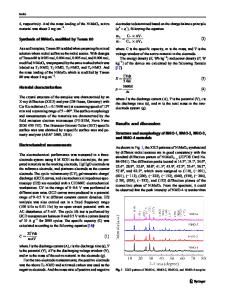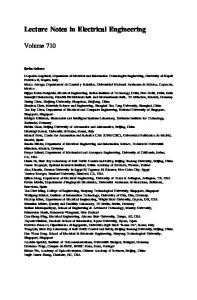Multi-functional NiO/g-C 3 N 4 hybrid nanostructures for energy storage and sensor applications
- PDF / 748,682 Bytes
- 10 Pages / 595 x 842 pts (A4) Page_size
- 67 Downloads / 328 Views
pISSN: 0256-1115 eISSN: 1975-7220
INVITED REVIEW PAPER
INVITED REVIEW PAPER
Multi-functional NiO/g-C3N4 hybrid nanostructures for energy storage and sensor applications Yen-Linh Thi Ngo, Jin Suk Chung†, and Seung Hyun Hur† School of Chemical Engineering, University of Ulsan, Daehak-ro 93, Nam-gu, Ulsan 44610, Korea (Received 30 December 2019 • Revised 19 January 2020 • Accepted 28 February 2020) AbstractA multi-functional NiO/g-C3N4 (NC) hybrid nanostructure was synthesized by a hydrothermal process using melamine and Ni(OH)2 as precursors followed by thermal treatment. The optimal conditions were determined by studying the process conditions, such as the Ni(OH)2 to melamine ratio and thermal treatment temperature. The NC prepared in this study exhibited both excellent glucose sensing properties and supercapacitor properties. A very high glucose sensitivity, as high as 5,387.1 A mM 1cm 2, and excellent energy density of 49.6 Wh kg 1 at a power density of 1,064.2 W kg 1 were obtained when NC was used as the electrode material for glucose sensing and symmetric supercapacitor, respectively. A flexible glucose sensing device using a flexible substrate and self-powered glucose sensor system that used the same material (NC) for the both power supply and sensing devices were also demonstrated. Keywords: Graphitic Carbon Nitride, Nickel Oxide, Glucose Sensor, Non-enzymatic Sensor, Supercapacitor
an electrode material in electrochemical reactions because of its good stability, low cost, and high catalytic activity towards the glucose oxidation reaction [15,16]. Thus far, different morphologies of NiO have been demonstrated using a range of preparation methods, and their morphology-dependent properties have also been widely studied [17-19]. On the other hand, the low conductivity and sensitivity of the pristine NiO electrode should be solved before NiO can be used as an electrode material for glucose detection. In this regard, a hybrid of NiO with highly conductive materials can lead to improved electrical and electrochemical properties [18,20]. Recently, graphitic carbon nitride (g-C3N4), a type of 2D material, has become a potential candidate in a range of applications, such as biosensors [21,22], energy storage [23-25], catalysts [26,27], photocatalysts [28], water splitting materials [29], and oxygen reduction reaction materials [30], because of its unique optical properties, thermal/chemical stability, and inexpensive synthesis process. In addition, g-C3N4 exhibits excellent electrical conductivity and effective charge transfer with other materials because of the high -conjugation of the sp2-hybridized N-substituted graphite framework [31]. Therefore, the hybridization of nanomaterials with gC3N4 can enhance their original properties for a range of applications, particularly in electrochemical sensors and energy storage. Previous studies have shown that the hybridization of electrocatalysts, such as NiMn2O4 [14] or Co3O4 [12] with conductive reduced graphene oxide, can strongly improve their electrocatalytic











